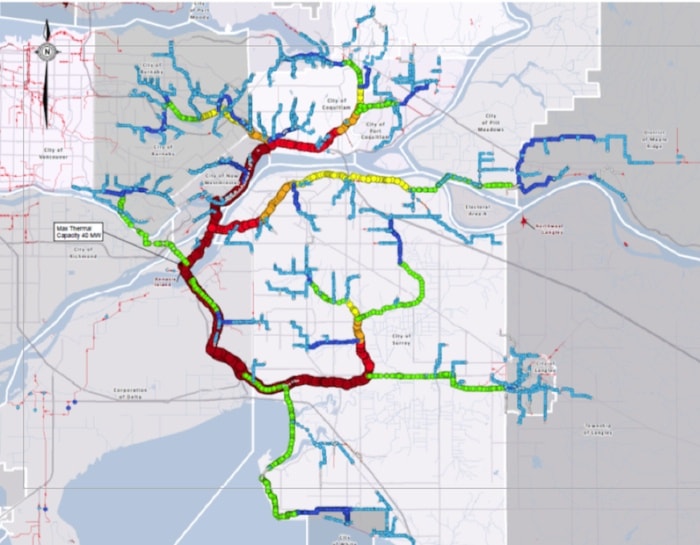The water that gushes out of the average home from flushed toilets or draining dishwashers and showers might not seem like a major energy source.
But Metro Vancouver staff estimate a huge amount of heat could be captured from the region's sewage – enough to heat 500 to 700 high-rise condo buildings.
"There really is tremendous capacity," said Jeff Carmichael, Metro's manager of utility research and innovation.
The technology involves diverting sewage from a Metro main to a heat exchanger, where the heat is passed into a different pipe network that then carries hot water to heat buildings, ideally via a district energy system.
"Sewage is warm," Carmichael explained. "So there are ways to wrap a pipe around that warm pipe and extract the heat."
The idea isn't new.
Vancouver's Olympic Village on southeast False Creek was built with a district energy system that captures 70 per cent of the heat it needs from city sewer lines – the first such project in North America, along with a companion system in Whistler.
Similar sewage heat projects are being actively considered elsewhere in Metro Vancouver as interest grows, Carmichael said.
New Westminster is looking at a major district energy network as part of the reconstruction of Royal Columbian Hospital as well as at Sapperton Green. Either project could tap sewage heat.
Richmond is exploring the potential use of sewage heat in a district energy system in the northern part of the city.
A study will also examine whether Vancouver International Airport could be partly heated by capturing heat from treated effluent before it's discharged to sea.
And Surrey recently studied options to use sewage heat in district energy systems being considered for its City Centre.
Sewage would generally supplement other heat sources.
The City of North Vancouver has an existing district energy system, which is powered mainly by natural gas, with some use of geothermal and solar heat as well.
The city is interested in using sewage heat there to reduce the amount of natural gas burned.
Metro staff have proposed to offer free use of its sewage to encourage the renewable, green source of energy on the basis that it helps reduces regional carbon emissions.
The regional district would charge municipalities or private proponents only to recover its costs for infrastructure changes, not to make money.
That has raised some eyebrows.
"As soon as you tell me the value of a raw material is zero because you're not doing anything else with it, I query that," said electoral area director Maria Harris.
The proposed policy on sewage heat is expected to go to a board vote in September.
But City of North Vancouver Mayor Darrell Mussatto said his staff want an iron-clad guarantee that any new project built on the promise of free use of sewage heat won't be charged for access later.
Carmichael said Metro would review the policy and the rates it charges in a few years, but added prices agreed to before then would be good for the life of the contract.
That's not good enough for Mussatto, who said municipalities should have free use of the sewage they generate – Metro shouldn't suddenly own it once it enters the region's pipes.
"Who owns the sewage?" he asked. "I think we need to be very clear about who owns what, where and when."
Cities should also get all the carbon credits resulting, he said, not Metro.
Greenhouse gas reductions aren't the only environmental benefit.
Extracting heat from sewage is better for marine life because the process cools the effluent so it's closer to the temperature of ocean water when discharged.
Cooler sewage also means less odour and corrosion of Metro pipes.
